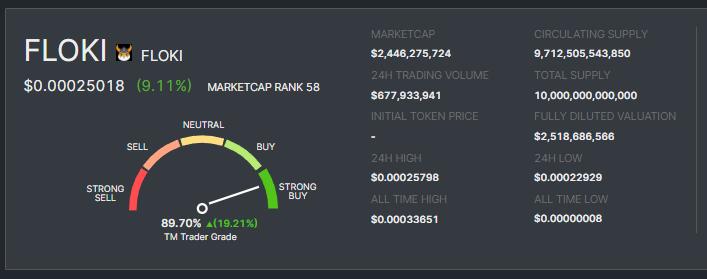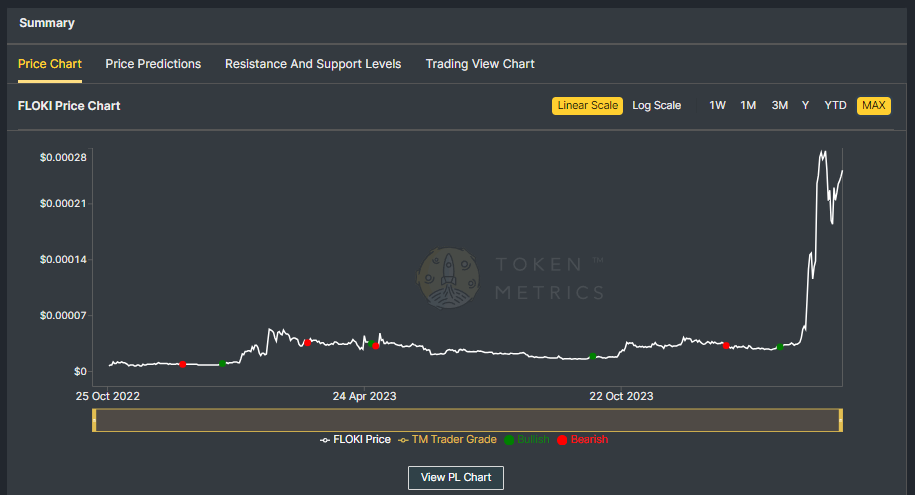
Floki Inu Coin Price Prediction 2025, 2030 - Forecast Analysis

In the dynamic space of cryptocurrencies, meme coins have garnered considerable interest. Among these, Floki Inu Coin has captivated the attention of investors and enthusiasts. With its distinctive branding and community-driven ethos, Floki Inu Coin has generated significant excitement in the market.
This article examines Floki Inu Coin's future potential, offering an in-depth analysis of price predictions for 2025 and 2030.
Floki Inu Coin Overview
Floki Inu, originally inspired by Elon Musk's dog and dubbed the "people's currency," has quickly gained popularity in the crypto market.

As a major player in the web3 space, Floki Inu spans decentralized finance (DeFi), non-fungible tokens (NFTs), and the Metaverse, aiming to become the premier meme-based cryptocurrency.
Historical Performance of Floki Inu Coin
Since its inception, Floki Inu has experienced significant volatility in its price. The coin has shown tremendous growth, with a staggering 162,223.13% return.

However, like many meme coins, Floki Inu faces a downtrend as the market shifts under bearish control.
Floki Inu Coin Current Fundamentals
Despite the current market conditions, Floki Inu is pioneering three transformative crypto projects:
- Valhalla: Dive into a gaming metaverse where users can engage, trade, and craft unique digital assets.
- FlokiPlaces: Discover a bustling marketplace for NFTs and exclusive goods, all powered by crypto. The NFT space remains vibrant, regardless of market trends.
- FLOKI coin's versatility: Seamlessly integrated to function on both the Binance Smart Chain and Ethereum.
These initiatives demonstrate Floki Inu's commitment to innovation and its potential for long-term growth.
Floki Inu Coin Price Prediction - Scenario Analysis
To provide a comprehensive price prediction for Floki Inu, we will analyze bullish and bearish market scenarios and consider industry expert opinions.
Floki Inu Coin Price Prediction - Bullish Market Scenario
In a bullish market scenario where positive market sentiment prevails, Floki Inu Coin's price has the potential to experience significant growth. Several factors could contribute to this bullish trend, including increased adoption, technological advancements, and positive regulatory developments.
If the crypto market cap hits $3 Trillion and Floki Inu Coin retains its current 0.08% dominance, its price could ascend to $0.000261.
In a more bullish scenario of the crypto market surging to $10 Trillion, Floki Inu Coin's price could soar to a staggering $0.000873, resulting in a potential 7x return for investors.
It is important to note that these predictions are based on various factors and assumptions, and market conditions can change rapidly. However, bullish market sentiment and increased adoption of Floki Inu Coin's solutions could drive its price to new heights.

Floki Inu Coin Price Prediction - Bearish Market Scenario
These predictions highlight the potential risks of investing in Floki Inu during a bearish market. It's crucial to assess the market conditions and make informed decisions.
In the event of a bearish market, Floki Inu Coin's price could experience a correction, potentially leading to a decrease in its value. In this case, the price of Floki Inu Coin may face downward pressure with a decreased dominance of 0.042%.
In this scenario, If the crypto market cap hits $3 Trillion, Floki Inu Coin could trade around $0.000130 in the short term and struggle to surpass $0.000436 by 2030 even if the total crypto market cap surpasses the $10 Trillion mark.
It is crucial to consider the potential risks and challenges that Floki Inu Coin may face. Factors such as regulatory developments, competition from other projects, and technological advancements can affect the growth trajectory of Floki Inu Coin.
Also Read - Next Crypto Bull Run
Floki Inu Coin Price Prediction - Industry Expert Opinion
Industry experts play a crucial role in providing insights into the potential future performance of cryptocurrencies. While their opinions may vary, it's valuable to consider their perspectives. Based on the analysis of various experts, the following price predictions can be considered:
The Changelly platform predicts Floki Inu Coin could reach $0.00290 to $0.00350 by 2030, and other industry analysts have varying opinions on the future price of Floki Inu Coin.
The Coincodex platform predicts that Floki Inu Coin could reach $ 0.000249 to $ 0.00118 by 2025. By the end of 2030, the price of Floki Inu Coin could reach $ 0.000634 to $ 0.001029.
While these predictions provide insights, it's important to remember that the crypto market is highly volatile and subject to various external factors.
Note - Start Your Free Trial Today and Uncover Your Token's Price Prediction and Forecast on Token Metrics.
Floki Inu Coin's Current Developments and Future Potential
Floki Inu's success depends on its ability to adapt to market conditions, innovate, and attract a strong community. The ongoing development of the Floki ecosystem, including Valhalla and FlokiPlaces, demonstrates the team's commitment to expanding the use cases and utility of the coin.
As the crypto market evolves, Floki Inu has the potential to establish itself as a prominent player in the meme coin space. However, it's important to stay updated on the latest developments and perform thorough research before making any investment decisions.
Also Read - Ripple (XRP) Price Prediction
Conclusion
In conclusion, Floki Inu Coin's price prediction involves careful historical performance analysis, current market conditions, and future potential. While a bullish market scenario may lead to significant price growth, a bearish market scenario can present challenges.
Considering the ongoing developments and industry expert opinions, Floki Inu has the potential to achieve notable milestones in the coming years. However, conducting thorough research, assessing market conditions, and making informed investment decisions are essential.
Remember, the crypto market is highly volatile, and prices can fluctuate rapidly. Always exercise caution and consult a professional financial advisor before making investment decisions.
Disclaimer
The information provided on this website does not constitute investment advice, financial advice, trading advice, or any other advice, and you should not treat any of the website's content as such.
Token Metrics does not recommend buying, selling, or holding any cryptocurrency. Conduct your due diligence and consult your financial advisor before making investment decisions.

.svg)

Create Your Free Token Metrics Account

.png)




%201.svg)
%201.svg)


%201.svg)









.svg)




.png)